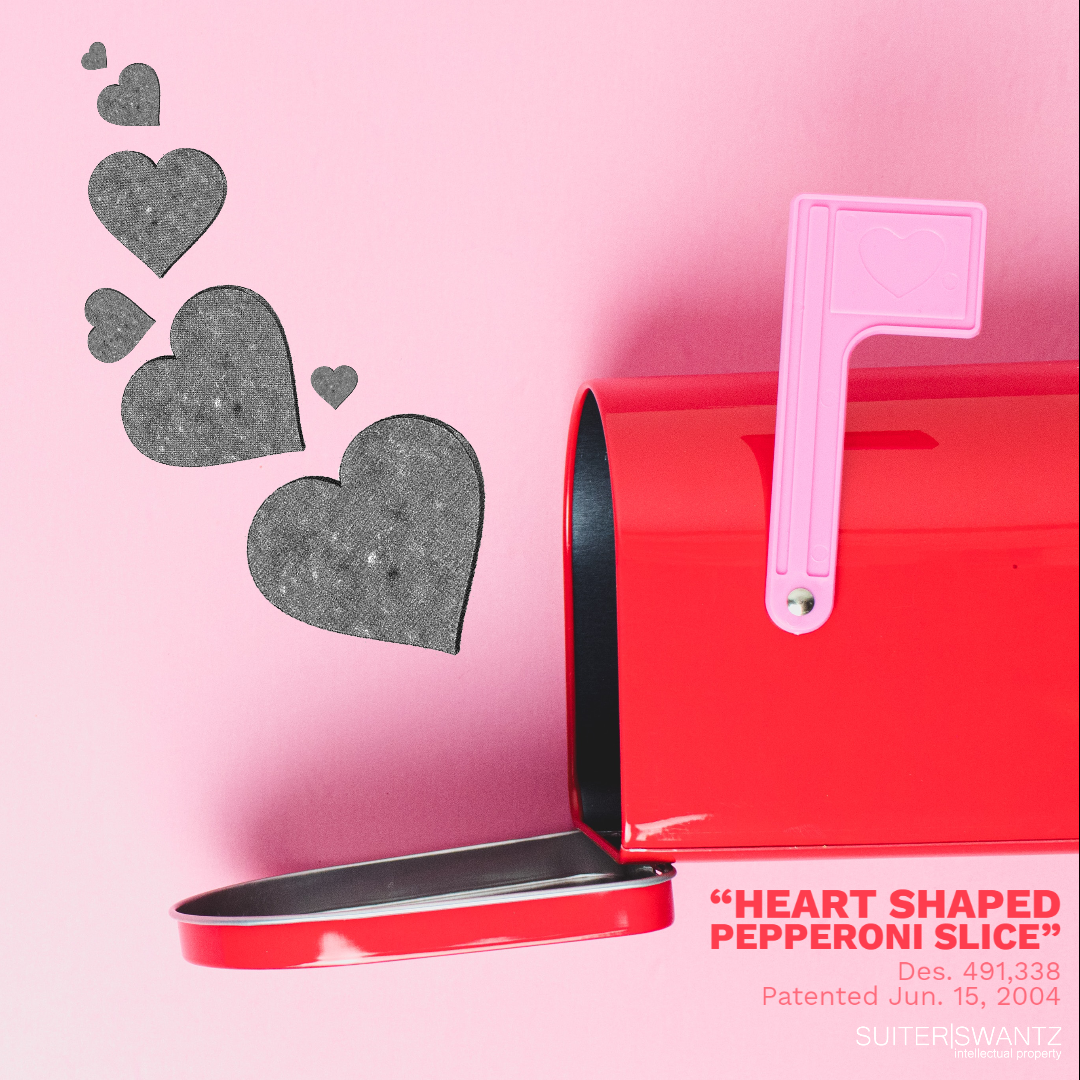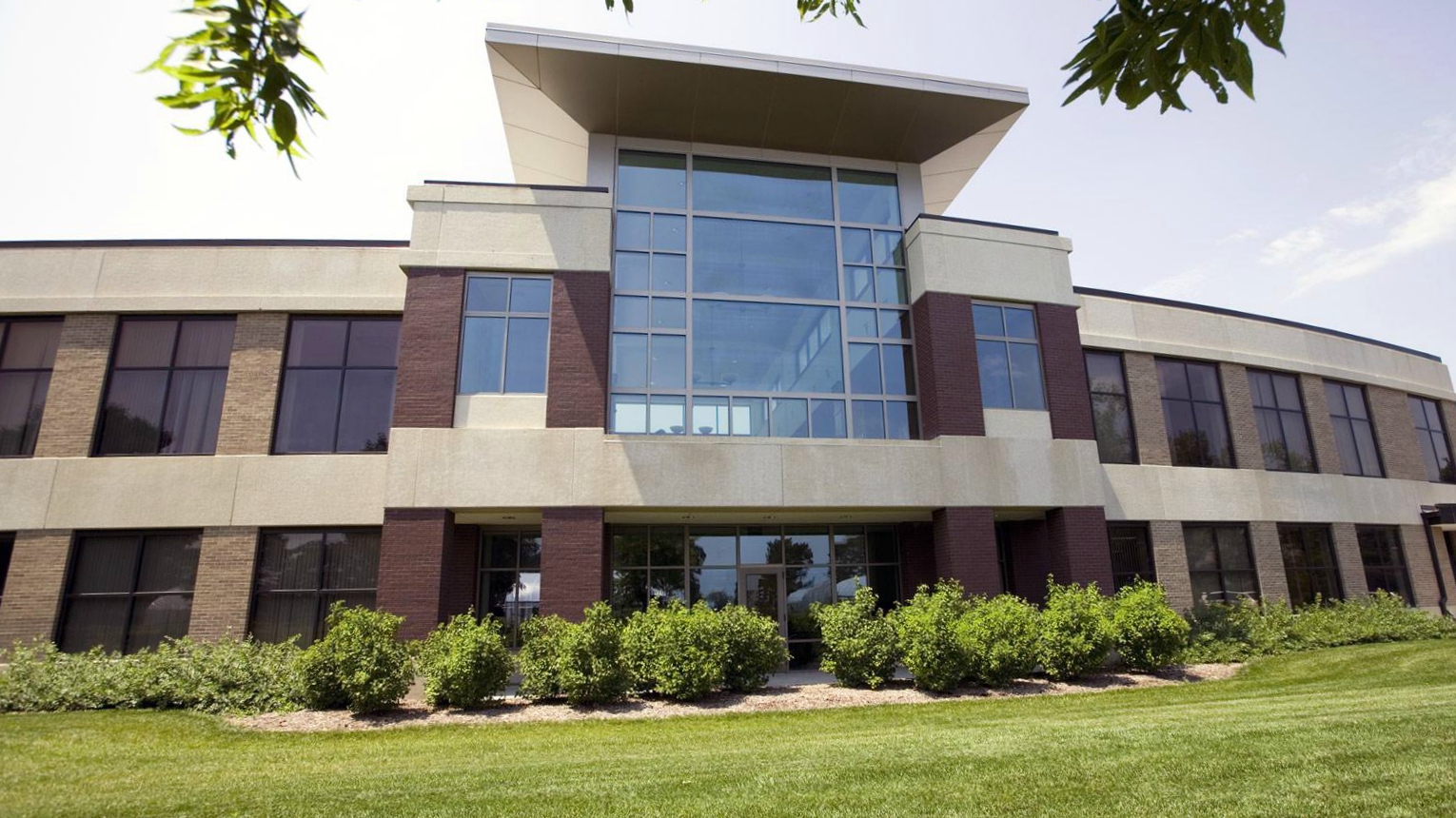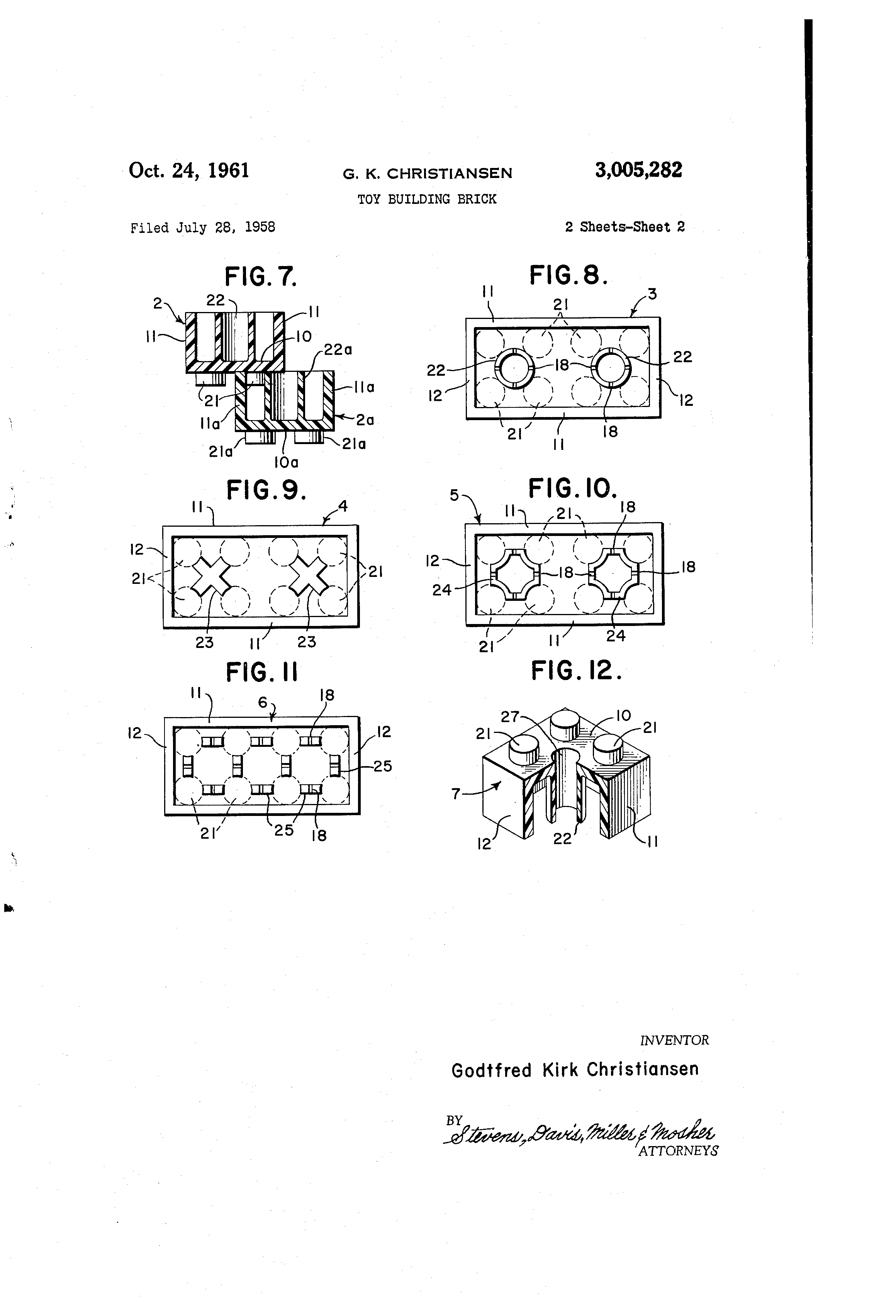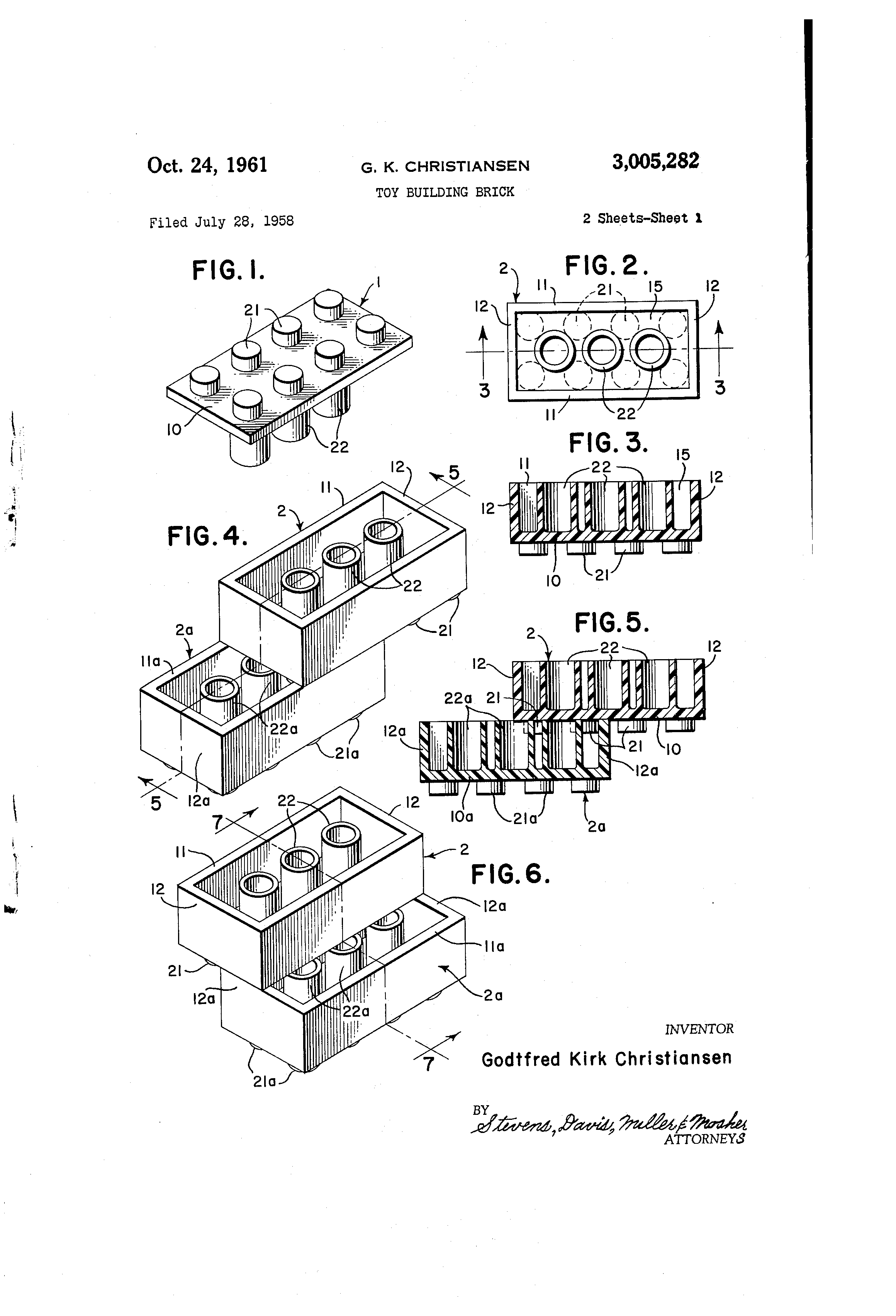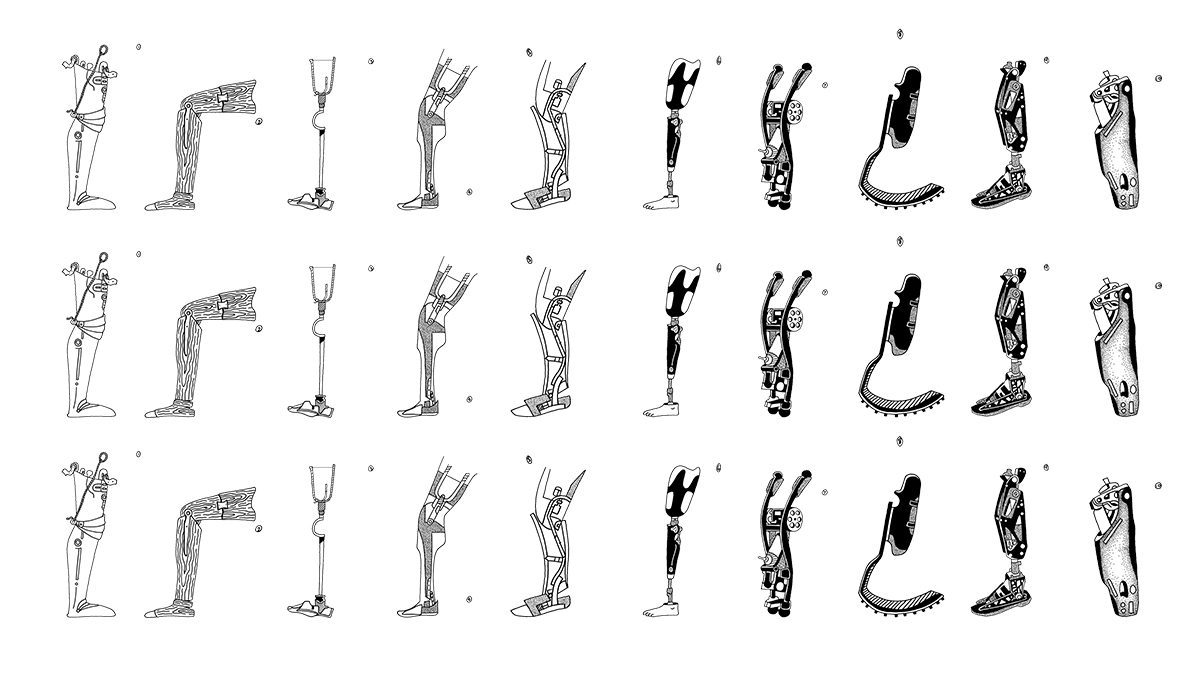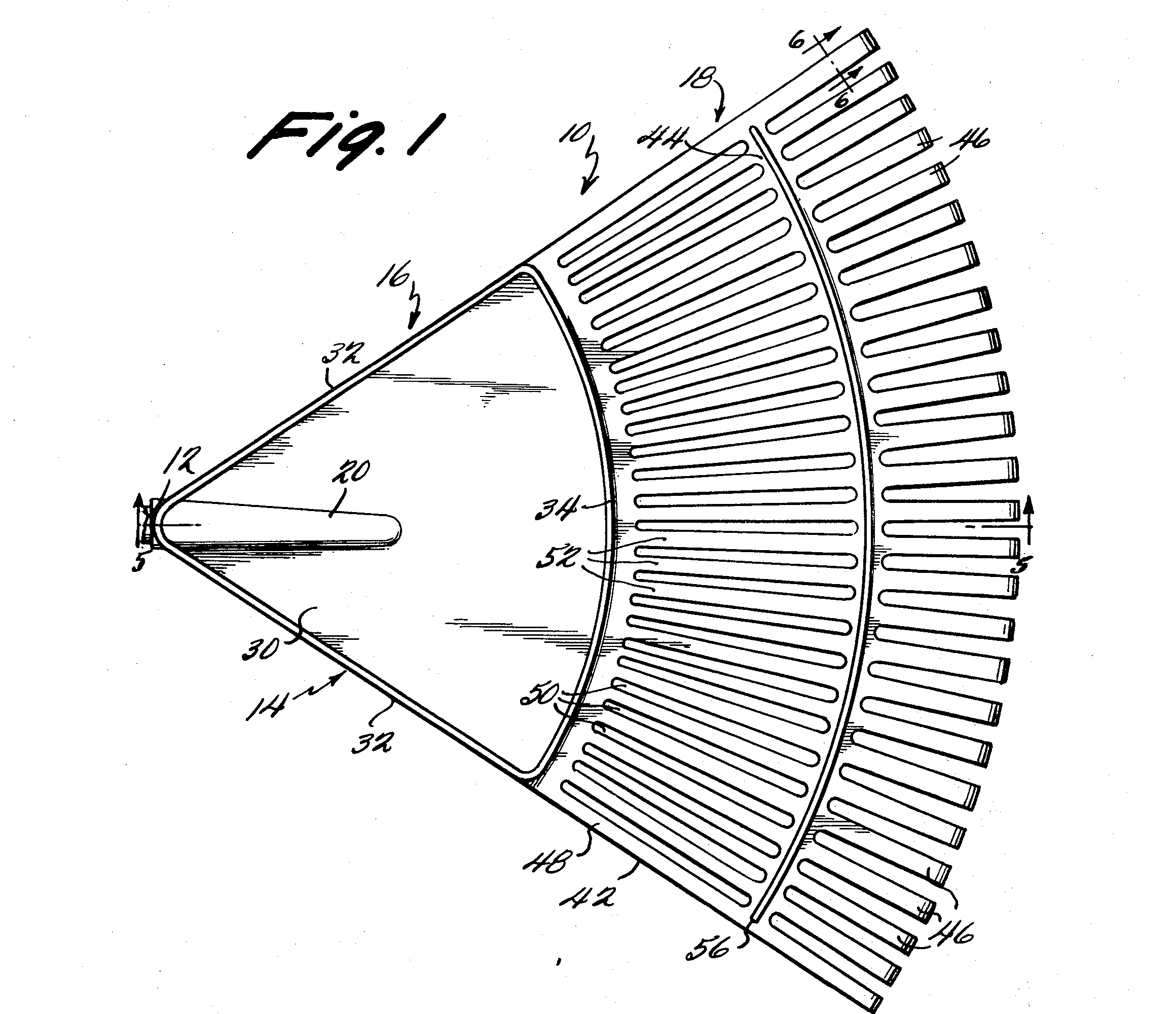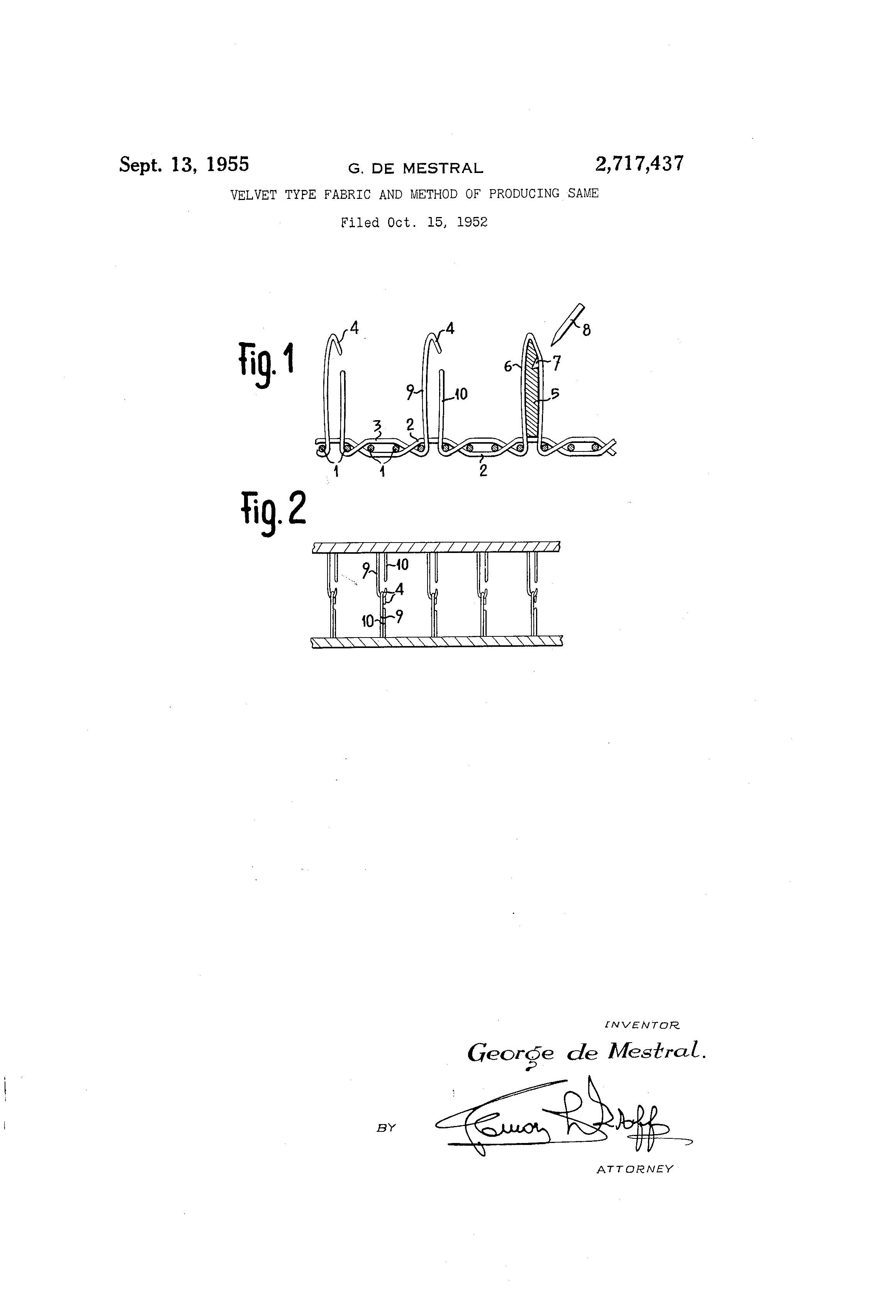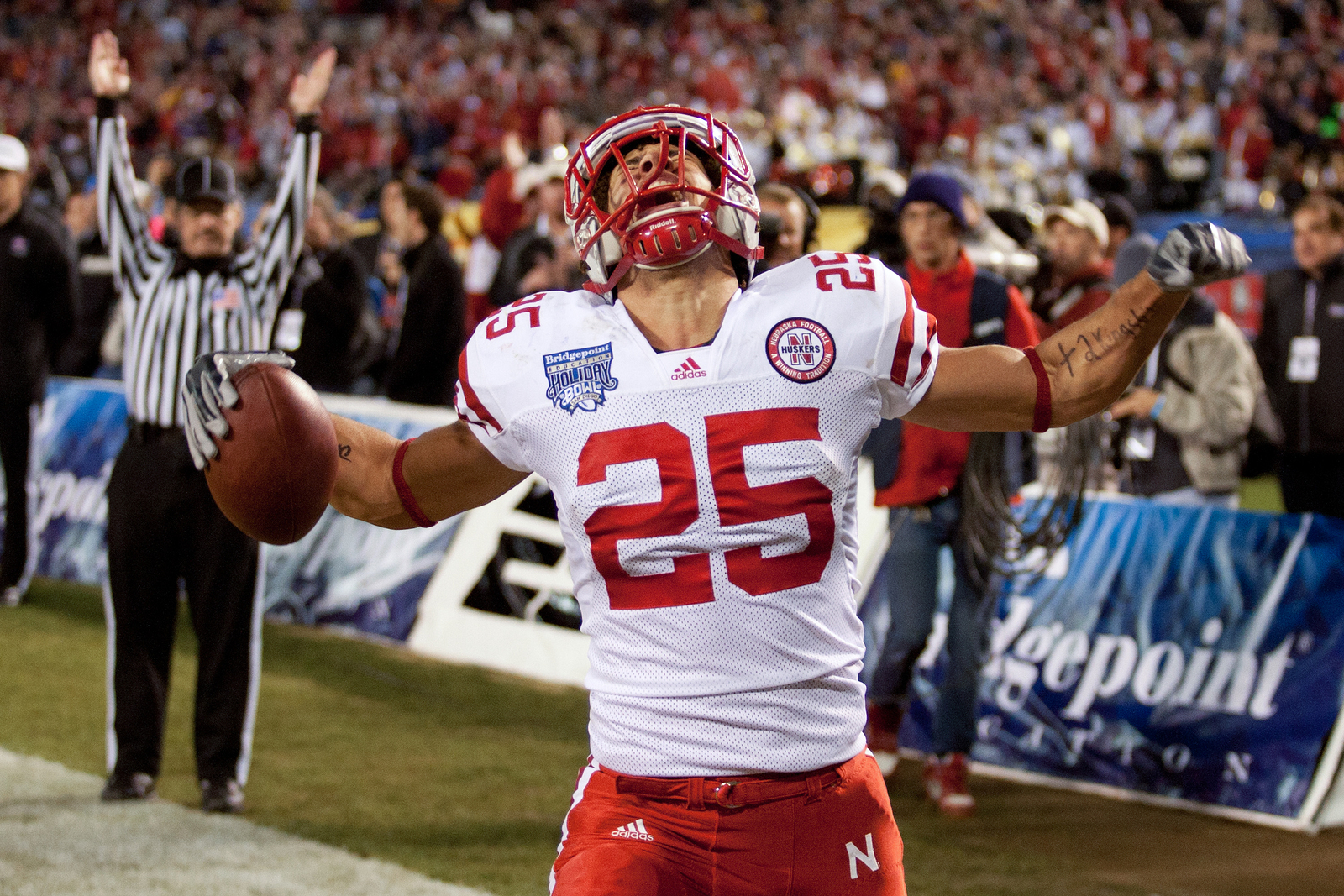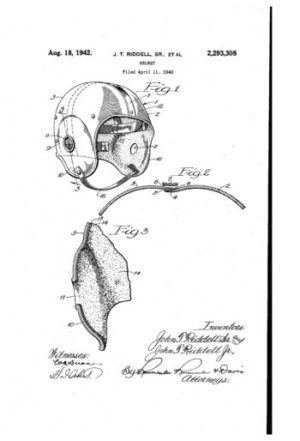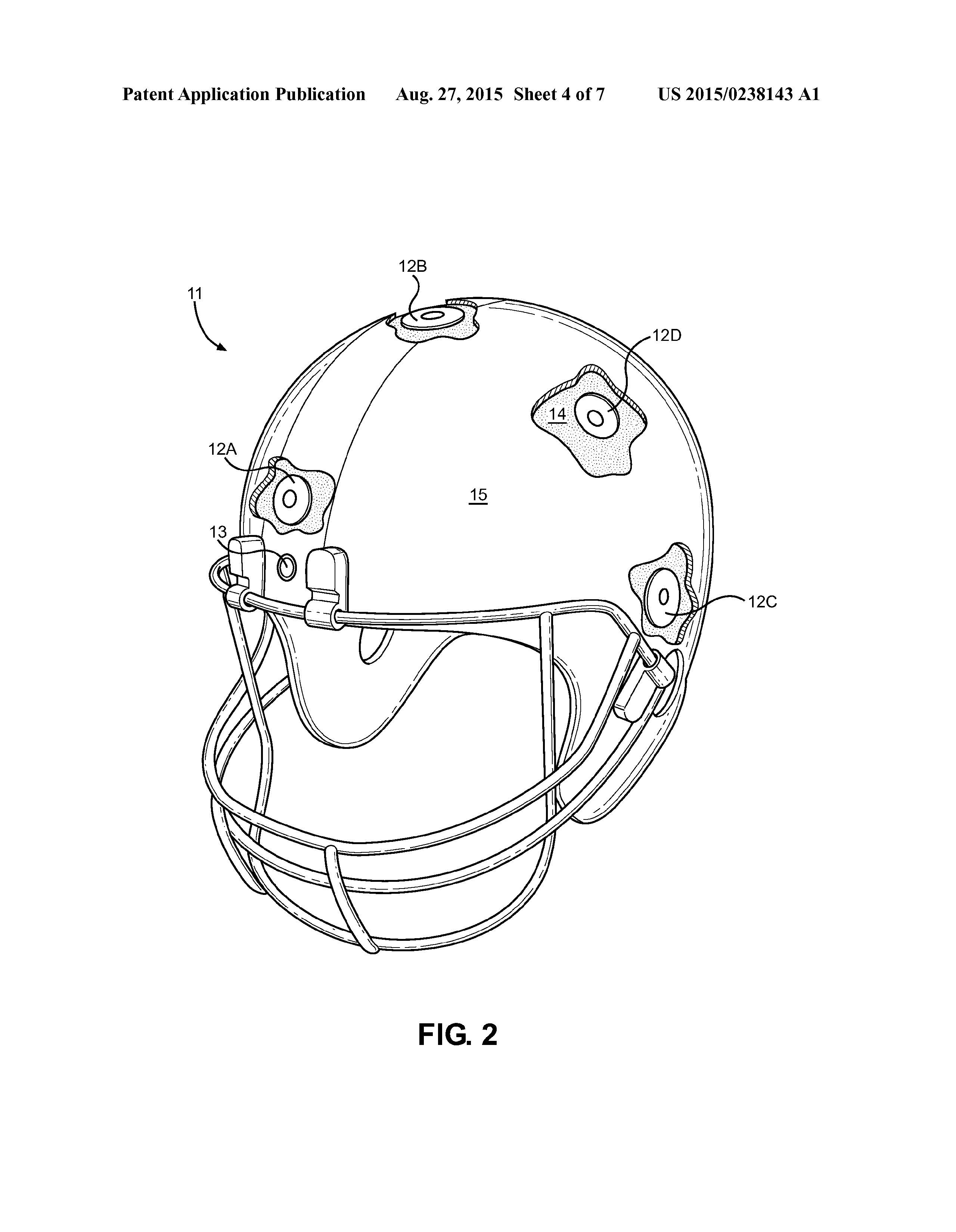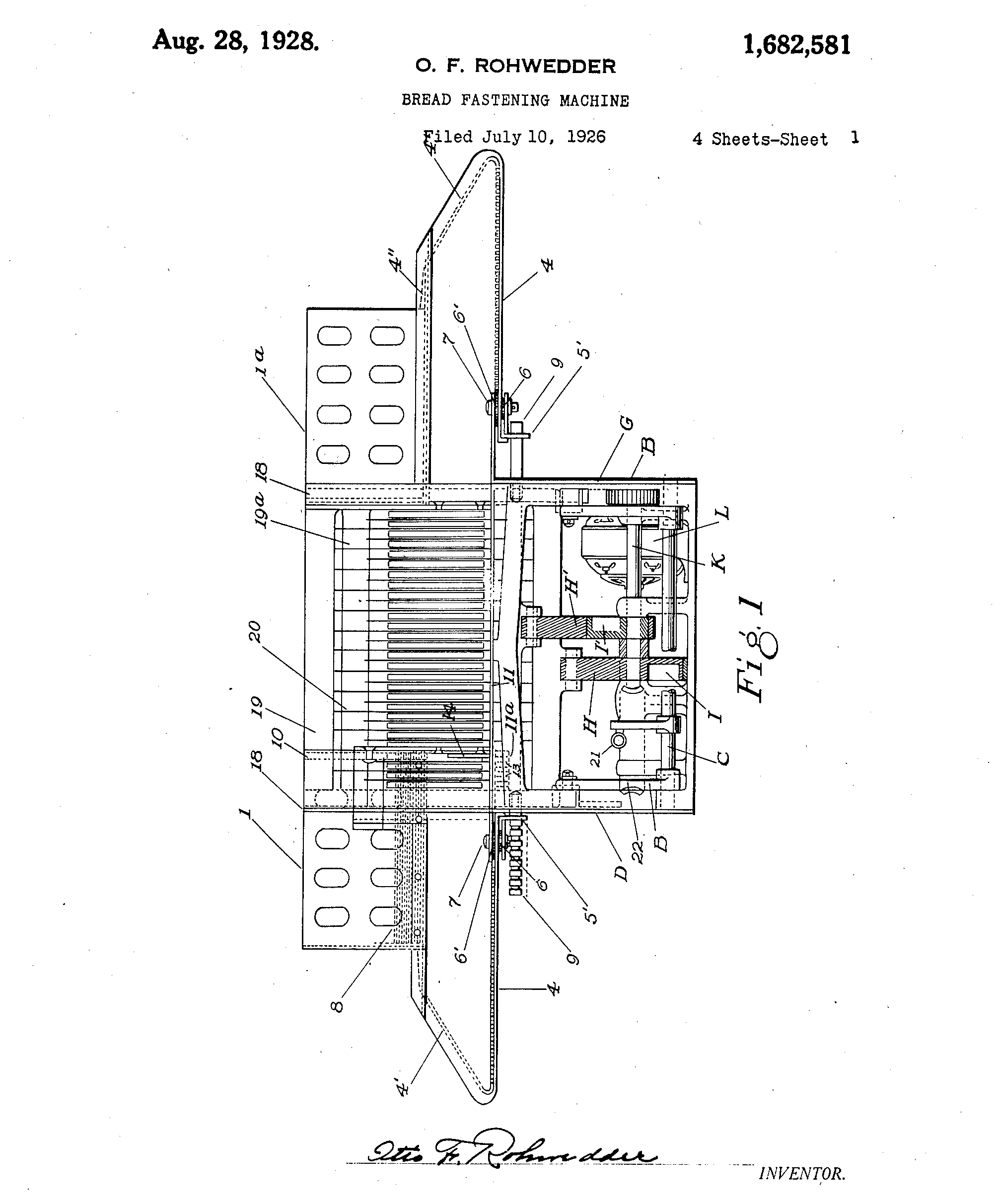Triumph of Ag Expo March 4th & 5th at CHI Health Center
Find us at the 54th Annual Triumph of Agriculture Expo Wednesday, March 4th and Thursday, March 5th!
The annual Triumph of Ag Expo is regarded as one of the largest indoor farm machinery shows in the Midwest and will feature the latest machinery, supplies, services, and technology in the agriculture industry. The free event is open to the public and will take place at CHI Health Center Omaha from 9:00 a.m to 4:00 p.m. on Wednesday, March 4th and from 9:00 a.m. to 3:00 p.m. on Thursday, March 5th.
Suiter Swantz IP has decades of experience working with agriculture related technology and businesses. Stop by our booth and visit one of our attorneys if you have any questions regarding patents, trademarks, copyrights, or other intellectual property protection.
Jon Horneber, Patent Attorney at Suiter Swantz IP, will discuss "Protecting Your Innovation" from 2:00 p.m. to 2:45 p.m. on Wednesday, and again from 11:00 a.m. to 11:45 a.m. on Thursday. See the full seminar schedule here.
This slideshow requires JavaScript.
--
Suiter Swantz IP is a full-service intellectual property law firm providing client-centric patent, trademark, and copyright services. If you need assistance with an intellectual property matter and would like to speak with one of our attorneys, please contact us at info@suiter.com.
Happy Valentine's Day from Suiter Swantz IP!
Whether you're celebrating the holiday with a loved one, yourself, or a friend, we can all get some enjoyment from the various pieces of popular intellectual property associated with Valentine's Day.
Did you know roses account for over four percent of issued plant patents? The very first plant patent issued by the USPTO was the Climbing or Trailing Rose, Plant Patent No. 1, granted in 1931 to Henry F. Bosenberg of New Jersey. Red roses are the flower most often sent on Valentine's Day and Fred H. Howard of California, received Plant Patent No. 953, for an early hybrid tea rose, on June 20, 1950. Its flower is described as rose red, very appropriate for Valentine's Day. 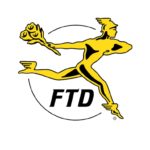
One of the most recognizable names in the floral industry is Florists' Transworld Delivery, Inc. ®, also known as FTD. FTD has a trademark on its symbol, a mythological character Mercury, which is the Latin version of the Greek god Hermes. The FTD mark depicts Mercury, or "Mercury Man," delivering flowers. They have also trademarked their phone number 1-800-SEND-FTD®, Registration No. 1848732.
For those with a sweet-tooth, Dove's famous Valentine's Day Chocolates have been in production since 2005 and became a registered U.S. trademark in 2008. And of course, no one can forget chomping on Sweethearts®, Registration No. 2172266.
 Jewelry is another popular gift on Valentine's Day. Such jewelry options include the TRIPLE HEART JEWELRY WITH DIAMOND OUTLINE, which was designed by Pascal Mouaward in 2012, and the HEART SHAPED DIAMOND CUT HAVING HEARTS AND ARROW PATTERN, covered by the utility patent U.S. Patent No. 8,353,181, issued in 2013. In 2002, Ami Haimoff patented a new method for creating a heart-shaped diamond, METHOD OF MAKING A HEART-SHAPED DIAMOND, covered by utility patent U.S. Patent No. 6,434,805. Haimoff's patented process includes cutting and placing two pear-shaped diamonds into a side-by-side setting to create a heart-shape.
Jewelry is another popular gift on Valentine's Day. Such jewelry options include the TRIPLE HEART JEWELRY WITH DIAMOND OUTLINE, which was designed by Pascal Mouaward in 2012, and the HEART SHAPED DIAMOND CUT HAVING HEARTS AND ARROW PATTERN, covered by the utility patent U.S. Patent No. 8,353,181, issued in 2013. In 2002, Ami Haimoff patented a new method for creating a heart-shaped diamond, METHOD OF MAKING A HEART-SHAPED DIAMOND, covered by utility patent U.S. Patent No. 6,434,805. Haimoff's patented process includes cutting and placing two pear-shaped diamonds into a side-by-side setting to create a heart-shape.
The majority of Valentine's Day-themed products seem to be accompanied by an endless number of jewelry-related commercials. Many of the catchy jingles and phrases heard in commercials also have their own have intellectual property protection. For instance, Kay Jewelers' "Every Kiss Begins with Kay"® is protected via Registration No. 2602439. Jared the Galleria of Jewelry protects the slogan "He Went to Jared" with Registration No. 4321229. Zales has also trademarked its slogan "Zales the Diamond and Valentine Gift Store."
For Valentine’s Day, we leave you with these parting words from Charles M. Schulz, American cartoonist and creator of the comic strip Peanuts, "All you need is love. But a little chocolate now and then doesn't hurt."
Happy Valentine's Day from all of us at Suiter Swantz IP!
Suiter Swantz IP is a full-service intellectual property law firm providing client-centric patent, trademark, and copyright services. If you need assistance with an intellectual property matter and would like to speak with one of our attorneys, please contact us at info@suiter.com
Matt Poulsen Teaching Patent Practice Course at Nebraska College of Law
Suiter Swantz IP Co-Owner & Patent Attorney Matt Poulsen is teaching the University of Nebraska College of Law's "Patent Practice and Innovation Management" course once again this spring.
Matt helped introduce the specialized course to the Nebraska College of Law's curriculum in spring of 2019. The course focuses on the life-cycle of patent-protected innovation and provides the opportunity for students to interact with real or simulated inventors and examiners. Students can also expect to gain an understanding of the nature and operation of patents, experience with patent searching, drafting and prosecution, and the strategic use of patents.
Matt Poulsen
Matt is an alum of the Nebraska College of Law in Lincoln, NE. Prior to receiving his J.D., Matt obtained his Ph.D., M.S. and B.S. in physics from the University of Nebraska.
Matt represents clients including large Fortune 500 companies, universities, startup companies, and individual inventors. His practice is generally focused on IP procurement and protection, including U. S. and foreign patent preparation and prosecution, patentability and freedom-to-operate analysis and various trademark, copyright, and trade secret matters. Matt also advises clients with respect to various startup related activities, such as early-stage IP strategy.
Suiter Swantz IP is a full-service intellectual property law firm providing client-centric patent, trademark, and copyright services. If you need assistance with an intellectual property matter and would like to speak with one of our attorneys, please contact us at info@suiter.com
Suiter Swantz IP 2020 U.S. Patent Calendar
Every holiday season, we enjoy creating a U.S. Patent Calendar that we send to our clients and friends of the firm. This year, we’ve also put together an online version that links our Patent of the Day articles, so you can learn more about some of the calendar's featured patents.
If you would like a complimentary physical copy of our 2020 U.S. patent calendar, please send an email with your name and address to info@suiter.com.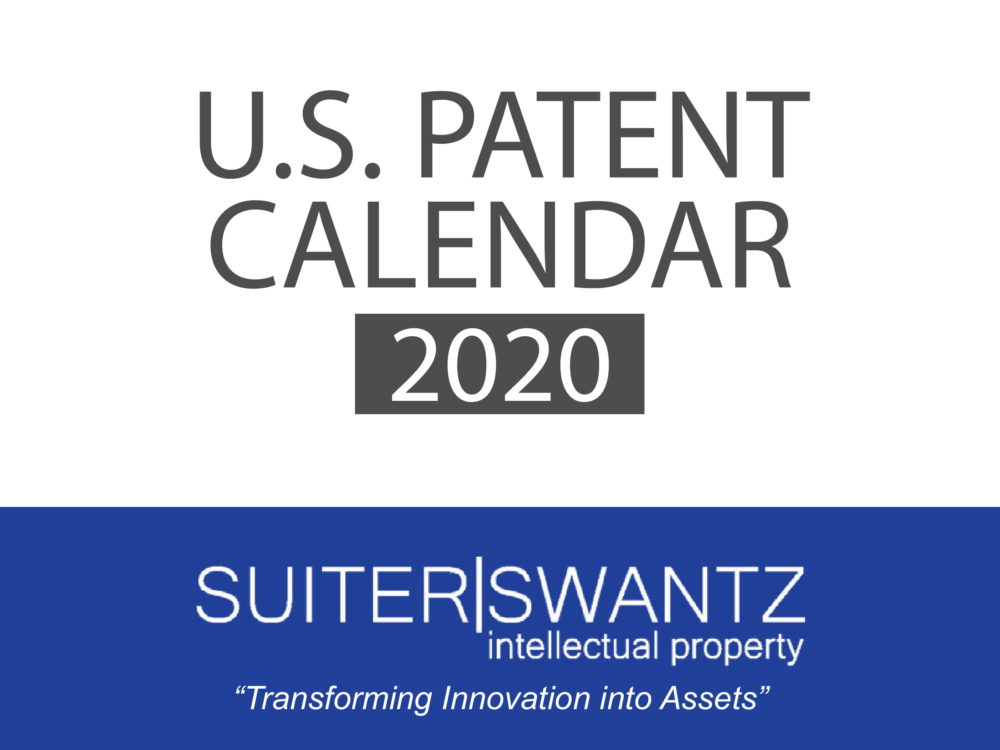
We hope you had a great holiday season!
Sincerely,
The Suiter Swantz team
The Patent Behind the LEGO "Toy Building Brick"
On October 24, 1961, Godtfred Kirk Christiansen was granted the patent for the LEGO TOY BUILDING BRICK, U.S. Patent No. 3,005,282.
Sixty years ago, Godtfred Christiansen filed a patent application for the basic building block, LEGO®. The building blocks were described as “[b]uilding blocks, strips, or similar building parts to be assembled without the use of additional elements provided with complementary holes, grooves, or protuberances.”
The LEGO Group began in the workshop of Danish carpenter, Ole Kirk Christiansen. Ole opened the shop with his 12-year-old son, Godtfred, in 1932. The father-son duo made items such as stools, ladders and ironing boards. The depression weighed heavily on Ole, and he decided to change his tactics and make things that would sell; it turned out he was an excellent toymaker and focused his craftsmanship on wooden toys. By 1934, Christiansen had success selling his toys and named his company “Lego” which comes from the Danish phrase “leg godt” meaning play well. Today, Kjeld Kirk Christiansen, grandson to Ole Kirk, owns LEGO.
When the Lego Group was first started it was focused on building wooden toys. Eventually, by 1947, it began to produce plastic toys. The Lego Group took a risk by switching from wood to plastic but the risk paid off when the toy building brick was named “Toy of the Century” by the British Toy Retailers Association as well as Fortune, twice.
One of the things that set LEGO apart from the competition is it put out specialized sets and licensed with movies and other companies such as Star Wars, Harry Potter, Toy Story, and more. The company also uses target marketing and has product lines marketed specifically towards girls and adults; including its Architecture Studio Set which has over 1200 pieces and no instructions. The company strives to inspire its customers to “Let your imagination guide your design.”
All around the world, there are LEGO museums and figures where you can see larger than life LEGO creations. A few of those notable creations include The Lego X-Wing which is a 23 ton, 5.3 million brick creation with a 44 feet wingspan. The Milan Lego Tower is at 114 feet tall with 580,000 bricks.
Suiter Swantz IP is a full-service intellectual property law firm providing client-centric patent, trademark, and copyright services. If you need assistance with an intellectual property matter and would like to speak with one of our attorneys, please contact us at info@suiter.com .
The Patent Behind the Iconic Flex-Foot Prosthetic
On October 22, 1985, medical engineer Van Phillips was granted U.S. Patent No. 4547913, for the "composite prosthetic foot and leg," under the newly founded Flex-Foot, Inc.
In 1976, when Phillips was 21, his left leg was severed below the knee in a water-skiing accident. At the hospital, he was measured for a pink wood-and-rubber leg and sent home. As a young and active individual, Phillips became frustrated by the stiff and uncomfortable prosthetic options at the time.
Phillips was determined not only to create a better prosthetic for others but to also return to his athletic lifestyle. When he was a student at the Northwestern University Medical School Prosthetic-Orthotic Center, professors often discouraged him from challenging the status quo where prosthetics were designed to resemble human attributes.
Borrowing concepts from pole vaulting, the spring of a diving board and the C shape of a Chinese sword his father owned, Phillips imagined a prosthetic that would let him jump and land. Between 1976 and 1984, Phillips tested his own models until he came to the final design, which allowed him to run again and brought upon the birth of Flex-Foot, Inc.
In 1996, the Flex-Foot Cheetah or Flex-Foot Sprint III was created. The Cheetah was constructed from 100 percent carbon fiber, a material used extensively in the aerospace industry for its superior strength and flexibility.
The unique shape of the Cheetah allows the prosthetic to flex and bend to impersonate foot ligaments and musculature. Because of the C-shaped segment, the kinetic energy from the wearer's steps distributes and provides for a vertical forward movement when the toe leaves the ground and propels the runner forward, simulating normal human gait. Every Cheetah prosthetic foot lacks a heel component and can be "tuned" for each athlete's individual running needs.
Since the "composite prosthetic foot and leg" patent was granted, Phillip has attained approximately 100 U.S. and international patents. Phillips has made it possible for amputees to live more prosperous, active lifestyles and participate in sports such as running, skiing, hiking, and climbing.
According to an article from the New York Times, many users of the Flex-Foot Cheetah prosthetic have gone on to compete in high school and collegiate athletics, Ironman triathlons, the Paralympic Games, and even the Olympic Games. Paddy Rossbach, president and chief executive of the Amputee Coalition of America, said: "Van Phillips's foot changed the whole field of prosthetics. It was an extraordinary change."
In 2000, Phillips sold Flex-Foot, Inc. to Ossur, a prosthetic and orthotic company based in Iceland, which continues to sell the Cheetah and other Phillips designs.
Today, Phillip still designs for himself at his home in Mendocino, CA and is dedicated to creating prosthetic legs for land mine victims in developing countries, along with prosthetics for other various activities like snorkeling, skiing, surfing, etc.
Suiter Swantz IP is a full-service intellectual property law firm providing client-centric patent, trademark, and copyright services. If you need assistance with an intellectual property matter and would like to speak with one of our attorneys, please contact us at info@suiter.com .
The Patent Behind Insulin
On October 9, 1923, Frederick Banting, Charles Best, and James Collip were granted the patent for “Extract Obtainable from the Mammalian Pancreas or from the Related Glands in Fishes, Useful in the Treatment of Diabetes Mellitus, and a Method of Preparing It” or Insulin, U.S Patent No. 1,469,994.
Type 1 diabetes (T1D) is an autoimmune disease that occurs when a person does not produce enough or any insulin. Without regulated insulin levels to maintain blood glucose levels, serious health problems can arise.
Before insulin was discovered, diabetes was considered a fatal disease. Typically, T1D is most commonly found in children and adolescents. Before the advancements of modern medicine, those diagnosed with T1D rarely lived a year after the diagnosis and suffered greatly; often with loss of vision, heart attacks, and kidney failure.
Although it is debated who the original discoverers of insulin are, many believe it is orthopedic surgeon, Frederick G. Banting, Dr. Charles Herbert Best, and biochemist, James Bertram Collip. Dr. John Macleod, physiologist, is also credited with helping as he provided a laboratory, cow pancreases for testing purposes, and more.
Dr. John Macleod was born in 1876 in Scotland. He studied medicine at Aberdeen University. Macleod did extensive research on diabetes and concluded that “impaired utilization of sugar was probably the major reason for hyperglycemia in diabetes.”[1] He moved to Toronto and was a Professor of Physiology at the University of Toronto, where he met Banting.
Dr. Frederick Banting was born in 1891 in Ontario, Canada. He studied medicine at the University of Toronto and served in the Canadian Army Medical Corps where he was wounded in the battle of Cambria and received the Military Cross for heroism under fire. Upon his return from the Army, Banting practiced orthopedic medicine but continued to come back to his most considerable interest, diabetes research. Banting was determined to discover how to successfully extract insulin from the pancreas before proteolytic enzymes destroyed it. He went to Macleod, who provided facilities to work in and was introduced to Dr. Charles Best.
Dr. Charles Herbert Best was born in 1899 in Maine. He enlisted in the Canadian Army in 1918. He returned from the Army a year later and attended medical school at the University of Toronto. Best was meant to be a summer research assistant for Macleod, but Banting needed help with his experiments so Best became Banting’s assistant. Along with Best, Dr. James Bertram Collip was also an assistant to Banting.
Dr. James Collip was born in 1892 in Ontario, Canada. He attended the University of Toronto at the age of 15 and received his doctorate in biochemistry by the age of 24. In April of 1921, he went to work with Macleod. In December of 1921, Banting and Best were having difficulties with their research so Macleod assigned Collip to work with them. Collip’s contribution was to “prepare insulin in a more pure, usable form than Banting and Best had been able to achieve”[2].
In the initial phases of testing, pancreases from dogs and cattle were used. They removed insulin from the pancreases, but early experiments showed toxic substances in the insulin, which caused adverse irritations and reactions. They went back to the drawing board to research how to extract insulin more purely. In later tests, they removed the pancreas from a dog and injected it with a purer form of insulin and were successful. They found the extract lowered blood glucose levels, and several dogs with diabetes lived due to the extract. According to the patent application, obtaining the pure form of insulin was done by:
"extracting the internal secretion or hormone from the fresh pancreas of Mammalia, or, from the fresh pancreas of cartilaginous fishes, or, from fresh related glands, (principal islets), of bony fishes, with a solvent capable of preserving the activity of the internal secretion or hormone and then separating it practically free from injurious substances including inert associated gland tissue, proteins, proteolytic enzymes, salts and lipoids[3]"
There had been many successful trials with animals, but the first success with a human was with 14-year-old Leonard Thompson. Thompson had type 1 diabetes and was near death when the trial began. The first trial was unsuccessful, but on the second attempt, when given the purer form, Thompson’s blood sugar levels decreased significantly, and he regained his strength and appetite. After perfecting this method, they sold it to the University of Toronto for $1. They wanted insulin to be available to all of those who needed it.
In 1923, Banting and Macleod were awarded the Nobel Prize in Physiology or Medicine. Banting did not agree with Macleod receiving the award as he felt his role was more supervisory and that Best should have been awarded instead. In the end, Banting shared his prize with Best and Macleod shared with Collip.
Suiter Swantz IP is a full-service intellectual property law firm providing client-centric patent, trademark, and copyright services. If you need assistance with an intellectual property matter and would like to speak with one of our attorneys, please contact us at info@suiter.com .
Celebrating National Coffee Day and the Role of Intellectual Property in the Coffee Industry
Today is National Coffee Day! Over 50 percent of the American population consumes coffee, with the average coffee drinker drinking 3.1 cups of coffee, driving an $18 billion coffee market.
While the exact origin of coffee has been the center of debate for centuries, there is one Ethiopian legend that many seem to associate with its creation. As the story goes, a goat herder noticed his goats eating red berries and behaving excitedly afterward so the goat herder decided to try some of the berries himself. He too saw the effects the berries had on him and brought some back to his monastery. The chief monk did not approve of the berries and ordered they be thrown in the fire. The other monks noticed an alluring aroma coming from the fire and discovered the berries had become beans. They removed the beans from the fire, ground them up, added water and voilà coffee. 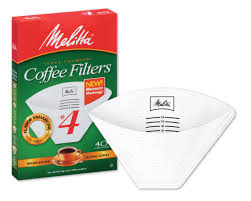 Coffee has come a long way since its discovery. One of the first American coffee patents was a COFFEE MILL, created by inventor and dentist Thomas Bruff and granted on January 8, 1798. The mill used two “teeth” to grind the coffee beans, which created coffee grounds. Typically, coffee grounds were mixed with water and consumed without the grounds being filtered. Melitta Bentz, a German housewife, was frustrated she had to drink her coffee this way and decided to invent something to prevent the grounds from being mixed in with the water. That led to the creation of the first coffee filter. Bentz’s filter was placed in a cone-shaped cup, and the grounds were placed in the filter. Hot water was then poured over the grounds, and the coffee dripped through the filter while the grounds remained trapped. The Berlin Patent Office granted Bentz the patent registration for FILTER TOP DEVICE LINED WITH FILTER PAPER on July 8, 1908. Shortly after that, Bentz went into business with her husband and opened Melitta®, a coffee filter company which is still in operation today.
Coffee has come a long way since its discovery. One of the first American coffee patents was a COFFEE MILL, created by inventor and dentist Thomas Bruff and granted on January 8, 1798. The mill used two “teeth” to grind the coffee beans, which created coffee grounds. Typically, coffee grounds were mixed with water and consumed without the grounds being filtered. Melitta Bentz, a German housewife, was frustrated she had to drink her coffee this way and decided to invent something to prevent the grounds from being mixed in with the water. That led to the creation of the first coffee filter. Bentz’s filter was placed in a cone-shaped cup, and the grounds were placed in the filter. Hot water was then poured over the grounds, and the coffee dripped through the filter while the grounds remained trapped. The Berlin Patent Office granted Bentz the patent registration for FILTER TOP DEVICE LINED WITH FILTER PAPER on July 8, 1908. Shortly after that, Bentz went into business with her husband and opened Melitta®, a coffee filter company which is still in operation today.
One of the first coffee makers was invented around 1810 by Sir Benjamin Thompson, a British physicist, and soldier. This percolator-style of coffee maker was improved upon and first patented in the United States by James H. Nason in 1865 (U.S. Patent No. 51,741). His percolator used a downward flow method to allow the steam and aromas to remain in the coffee pot, which allowed for a better coffee flavor. Some coffee drinkers still prefer to use this method today.
A more recent innovation in the coffee industry is the invention of single brew filters by Keurig®. Keurig has changed the way cups of coffee are brewed with the BEVERAGE FILTER CARTRIDGE (U.S. Patent No. 5,325,765), which Keurig refers to as a “K-Cup.”
 In addition to advances in coffee brewing technology, there has been a significant growth in the number of coffee shops in America. While it may not be everyone’s favorite, Starbucks is one of the most popular and widely recognized coffee shops in the world. Their signature mermaid enclosed within a green circle was trademarked in 1971 and is still used today (Registration No. 1417602). Starbucks is also the holder of multiple patents, including a design patent for a unique hourglass-shaped COFFEE BREWER (U.S. Patent No. D606,805) and a patent for their famous drink sleeve that keeps your hands cool while holding the cup, INSULATOR SLEEVE FOR A BEVERAGE CONTAINER (U.S. Patent No. 7,922,031). Starbucks also has a patent on its mobile ordering system MOBILE BASED VOICELESS DRIVE THROUGH ORDERING SYSTEM AND METHOD (US 2013/0024299).
In addition to advances in coffee brewing technology, there has been a significant growth in the number of coffee shops in America. While it may not be everyone’s favorite, Starbucks is one of the most popular and widely recognized coffee shops in the world. Their signature mermaid enclosed within a green circle was trademarked in 1971 and is still used today (Registration No. 1417602). Starbucks is also the holder of multiple patents, including a design patent for a unique hourglass-shaped COFFEE BREWER (U.S. Patent No. D606,805) and a patent for their famous drink sleeve that keeps your hands cool while holding the cup, INSULATOR SLEEVE FOR A BEVERAGE CONTAINER (U.S. Patent No. 7,922,031). Starbucks also has a patent on its mobile ordering system MOBILE BASED VOICELESS DRIVE THROUGH ORDERING SYSTEM AND METHOD (US 2013/0024299).
Whether you live and breathe coffee, or simply enjoy the occasional cup, take time today to appreciate how far coffee has come with the help of inventors and intellectual property.
Suiter Swantz IP is a full-service intellectual property law firm providing client-centric patent, trademark, and copyright services. If you need assistance with an intellectual property matter and would like to speak with one of our attorneys, please contact us at info@suiter.com .
Rake in the Fall Leaves with These Patents
It's officially the first day of fall! For many, this means decorating their home with bright pumpkins and gourds, bringing out their sweaters to prepare for the cooler weather, and enjoying the colorful foliage that comes with the season.
As leaves begin to turn to their yellow, orange, red, and brown hues, it's also a reminder to homeowners of what is to come-- falling leaves. Some prefer to keep leaves on the ground to help put nutrients back in the soil; while others will spend day and night trying to keep the grass as green as possible for as long as possible. For the latter individuals, the rake becomes their closest companion through the season. For this week's patent history, we're examining 3 types of historic garden rakes.
1. Edmund Brown - U.S. Patent No. 148,660
One of the first rakes to be issued a patent was invented by Edmund Brown in 1874 (U.S. Patent No. 148,660). This rake was comprised of a bamboo handle and metal teeth. Brown noted other rakes were continually “clogged by the refuse matter which they collect,” which led to the user removing the debris from the rake by hand. Brown’s rake was able to maneuver the debris more conveniently with the “automatic clearing attachment for iron-tooth door-yard rakes." This attachment removed "all matter that may be collected between the teeth by simply raising the rake from the ground.”
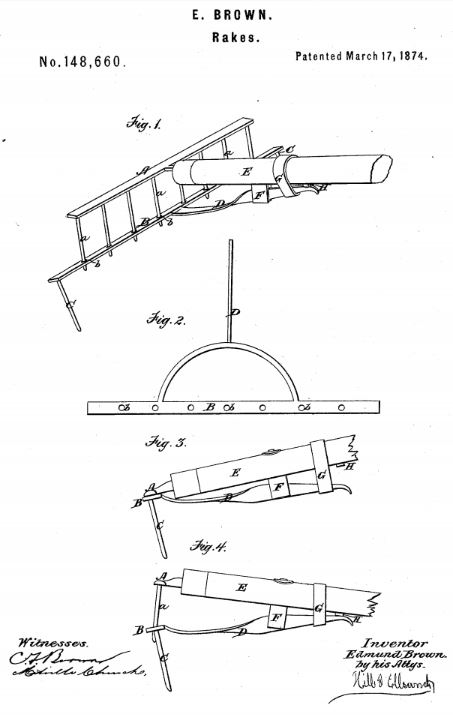
2. C.J. Rocquin - U.S. Patent No. 1,706,547
One of the more popular rakes still used today was invented by C.J. Rocquin and patented in 1929, (U.S. Patent No. 1,706,547). This invention was one of the first rakes that was able to be "manufactured with a minimum number of parts quickly." The way this rake was structured also made replacing any broken teeth of the rake easier, which was a marketable convenience at the time. Rocquin was later granted five additional patents for improvements in rakes and other tools.
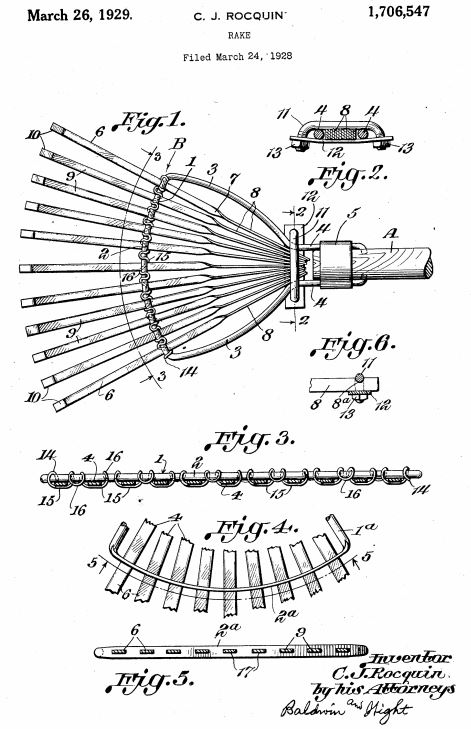
3. Harold O. Eads - U.S. Patent No. 3,724,188
Harold O. Eads was granted a patent in 1973 for another popular type of rake still used today, the plastic rake (U.S. Patent No. 3,724,188). Eads worked for the Ames Company, one of the biggest rake manufacturers in the 1970s. Upon inventing this rake, he sought to “provide a rake which has all of the advantages of both steel tine rakes and bamboo rakes, without the disadvantages thereof.” Eads was also granted a design patent for the rake head in 1974 (U.S. Patent No. Des. 233,305).

Looking for more fall-themed intellectual property history? Kick Off the Football Season with These 5 Historic Patents or learn more about Halloween and Intellectual Property.
Suiter Swantz IP is a full-service intellectual property law firm providing client-centric patent, trademark, and copyright services. If you need assistance with an intellectual property matter and would like to speak with one of our attorneys, please contact us at info@suiter.com.
A Brief Patent History of Velcro®
On September 13, 1955, George de Mestral was granted the patent for VELVET TYPE FABRIC AND METHOD OF PRODUCING SAME (Velcro®), U.S. Patent No. 2,717,437.
George de Mestral, a Swiss engineer and the man credited with inventing "velvet type fabric," came up with the idea for Velcro® after he and his dog went on a hike. After returning from the walk de Mestral and his four-legged friend were covered in burrs. Fascinated by the burrs’ structure, de Mestral examined them further to see if he could replicate their structure into something useful.
De Mestral’s examination of the burrs uncovered minuscule hooks that allowed them to easily attach to whatever they came across. This discovery led to de Mestral’s hook-and-loop fastening system. For de Mestral, creating the hook was the easy part, creating the loop for the hook to attach proved troublesome. De Mestral experimented with multiple fabrics but found none of them worked how he wanted. While experimenting with different textiles, a piece of nylon thread was accidentally added to one of the test fabrics, leading Mestral to discover that nylon was the fabric he needed. It was durable and created a strong bond for the hook to fasten to.
De Mestral decided to name his new creation Velcro®, a combination of the French words “velour” and “crochet,” which in French means "velvet hook."
After the invention was completed, de Mestral quickly filed a patent on the material and released it for commercial use shortly after. He marketed it as the “zipper-less zipper." Unfortunately for de Mestral, the product's success wouldn't come until years later when NASA adopted its use in the 1960s. NASA used Velcro® to secure items such as pens, food, equipment, etc. From there, its popularity grew, and now has many uses in fashion, homes, and businesses.
It should be noted that Velcro® Brand is the company’s brand name and not the general term for it, which is hook-and-loop. According to Velcro’s® website, “not all hook and loop fasteners are the genuine Velcro brand products!" Their website also has this genuine, but comical, disclaimer from their legal team regarding the use of the word Velcro®.
“We know. You don't mean to be a serial verber, but we decided to clear a few things up about using the VELCRO®trademark correctly – because we're lawyers and that's what we do. When you use "velcro" as a noun or a verb (e.g., velcro shoes), you diminish the importance of our brand and us lawyers would lose our *insert unfastening sound*.”
There is a reason for this disclaimer; when a term becomes too popular, it could potentially lose its trademark protection and become a generic term. This can have a devastating effect on a brand because marks that are merely generic are not subject to trademark protection.
The Velcro® brand company furthered this message by putting together this hilarious YouTube video titled “Don’t Say Velcro.” The video’s intro is “a message from the lawyers at Velcro Companies.”
Suiter Swantz IP is a full-service intellectual property law firm providing client-centric patent, trademark, and copyright services. If you need assistance with an intellectual property matter and would like to speak with one of our attorneys, please contact us at info@suiter.com.
Kick Off the Football Season with These 5 Historic Patents
It’s that time of year again! The long-awaited football season is upon us.
Teams are getting ready to storm the field, while fans are making plans to pack the stands and cheer on their favorite team. Football has seen many changes since its inception, and unsurprisingly, intellectual property rights have played a significant role in influencing those improvements. Today we're highlighting five historic patents from America's most-watched sport.
1. Foldable Stadium Chair
As any seasoned football spectator knows, metal benches can get uncomfortable quickly. Fortunately, Francis H. Chute invented a solution in 1961 he called the “FOLDABLE STADIUM CHAIR,” (U.S Patent No.3,066,980). Chute's chair adds an element of comfort to the hard bleachers and can be secured to any stadium bench seating. This invention has allowed many to enjoy sporting events longer and has helped prevent many sore backsides.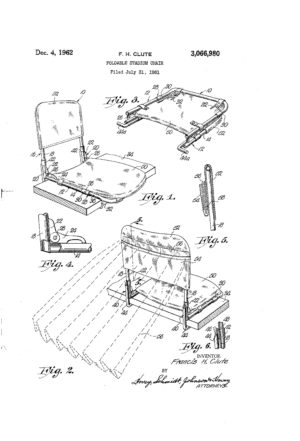
2. Blending a Graphic
Before James R. Gloudemans, Richard H. Cavallaro, Stanley K. Honey, and Marvin S. White invented a system for “BLENDING A GRAPHIC” (U.S. Patent No.6,229,550), determining which yard line a football landed on was difficult to see, especially from a home television.
Their invention led to the display of the Virtual Yellow 1st & Ten® technology which depicts where the first down lines are during a game. This little yellow line has made it much easier to watch televised games as it shows the viewer where the team is and where they need to advance to in order to score or get a first down.

3. The Helmet
Riddell invented the first plastic suspension helmet in 1939. Riddell’s helmet replaced the soft leather helmets formally used with a plastic shell and webbed suspension that could absorb some of the impact to the head when a player was struck on the field. The company continued to find success after John T. Riddell passed away in 1945, exclusively outfitting all NFL teams (with the exception of the New England Patriots) from the mid-1970s to 2013.
In the hopes of encouraging innovation and prevention of head injuries, the NFL revoked Riddell’s exclusive branding rights as “the official helmet of the NFL” at the end of the 2013 season. Today players are encouraged to use “top-performing” helmets as listed by the NFL. Riddell currently produces nine of the 27 models listed as “top-performing.”
4. Helmet Head Impact Tracking and Monitoring System
In recent years, the NFL has contributed more heavily to medical research for football-related injuries, with a majority of funding going towards concussion research. One popular area of advancement has been the design and implementation of newer, safer helmets and wearable technology.
Inventor Russell Meurer patented a device in 2015 that aimed to detect impacts strong enough to cause a concussion, U.S Patent Application Publication No. 2015/0238143 A1. According to the patent, when a qualifying impact is detected, the device uploads the data to the user and/or a third party and notifies surrounding individuals that the user may have suffered from a concussion and needs to be evaluated. The goal for this device (and other similar technologies) is to detect concussions sooner, so players and coaches can be more proactive in the treatment of concussions.
5. Detachable Streamers
For those who love the game but fear the impacts of tackle football, flag or touch football has always been a safer alternative, especially for younger children. Although flag-football was invented long before 1960s, U.S Patent No. 3,063,718 is one of the many innovations that helped improved the game.
In 1962, Frederick E. Steinkamp recognized that playing touch football was difficult because there was no way to determine whether a touch had been made or not. Others tried to solve this problem by attaching towels or handkerchiefs to player’s belts but that proved to be inconsistent because the detachable elements were not uniform and could easily fall out of place. Steinkamp’s invention created a belt with two flags attached with a material similar to Velcro® on each side. These detachable streamers are still used widely today by youth and adult flag-football teams.

Innovation continues to improve all aspects of football, from the player's uniforms to the devices used to broadcast and watch the game. Without the inventors and scientists that strive to make football safer and better, it would not be the sport we know and love today.
Suiter Swantz IP is a full-service intellectual property law firm providing client-centric patent, trademark, and copyright services. If you need assistance with an intellectual property matter and would like to speak with one of our attorneys, please contact us at info@suiter.com.
The Best Patent History Post Since Sliced Bread
On August 28, 1928, Iowa native, Otto Frederick Rohwedder was granted U.S. Patent No. 1,682,581 for his “Bread Fastening Machine."
Rohwedder's began his work on the invention more than a decade earlier in Chillicothe, Missouri. After many years of setbacks, challenges, and hard work, the "Bread Fastening Machine" would become the first automatic commercial bread slicer that could also package loaves into a sealed bag. Many have heard the phrase “the best thing since sliced bread,” which can only mean that sliced bread is the epitome of great inventions. 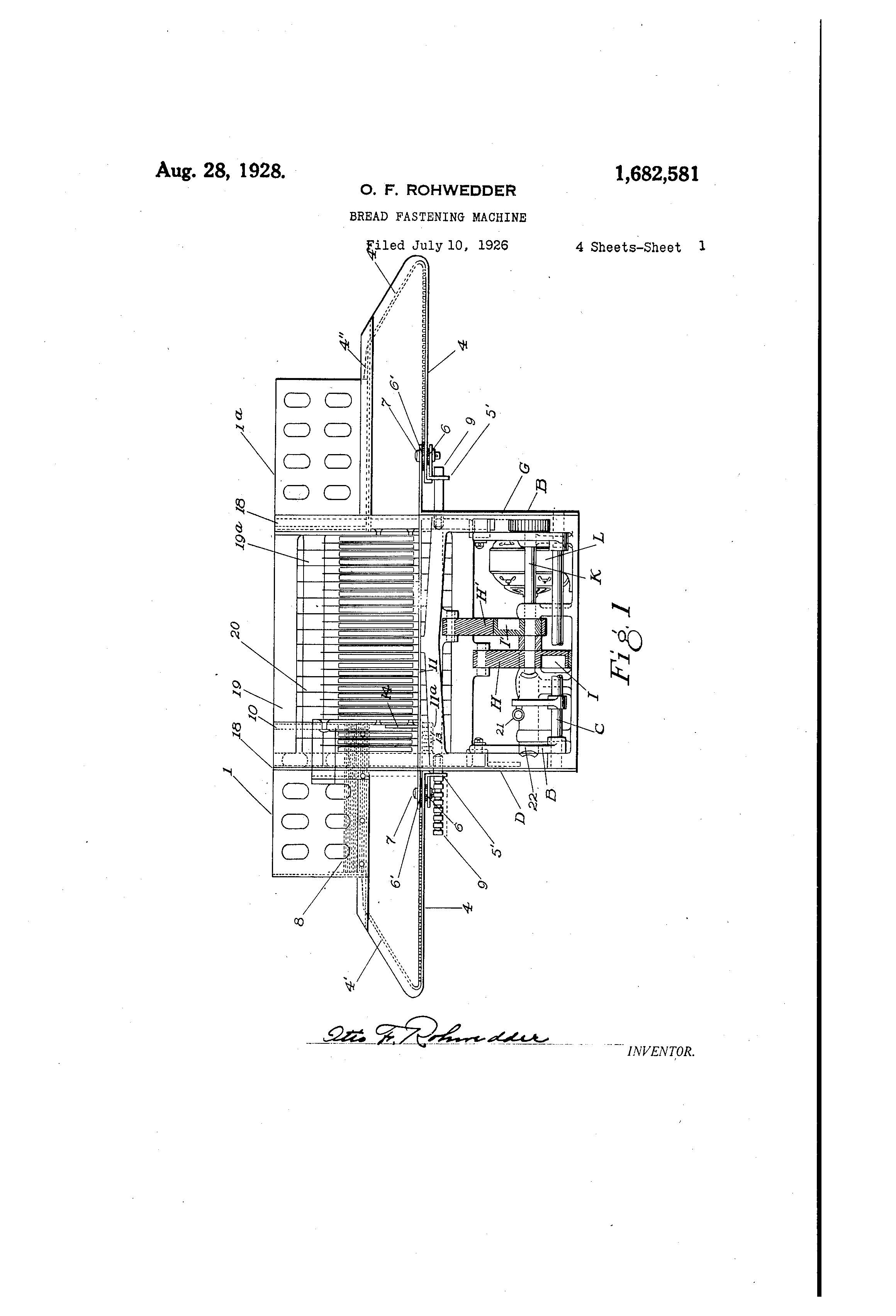
Early life
Rohwedder was born in Davenport, Iowa in 1880. He graduated with a degree in optics and started his career as a jeweler, eventually owning three jewelry stores. He enjoyed tinkering with watches and other gadgets in his spare time, and some believe this, in addition to his knowledge of consumer habits, led him to create the bread slicer. At one point, Rohwedder surveyed more than 30,000 people, finding that consumers collectively disliked the mess and inconvenience that came with slicing their own bread.
The first prototype
In 1916, Rohwedder sold all three of his jewelry stores and began to work on a bread slicer prototype. The three main objectives for the machine were to
- "provide an appliance which could be used in combination with a bread slicing machine that would secure together the slices of bread when cut."
- “hold each end of the loaf and permit slices at the middle section of the loaf to be taken out so that the remaining portions of the loaf can then be placed in juxtaposition”
- “provide means for preventing the drying out of the loaf of bread when cut by retaining one or both ends or crusts in their original position and avoiding the exposure of the cut surface of the loaf to the air.”
Selling the bread slicer
In 1927, Rohwedder finished the machine and sold the first one to his friend and baker, Frank Bench. Sales of the machine were not high at first because many believed sliced bread became stale faster. Rohwedder persisted and continued to make improvements to the invention. Eventually, people came to appreciate the ease of pre-sliced bread, and by 1928, word spread and sales increased dramatically.
From 1927 to 1936, Rohwedder obtained seven more patents relating to methods of slicing bread and eventually sold his patent rights to Iowa company, Bettendorf.


